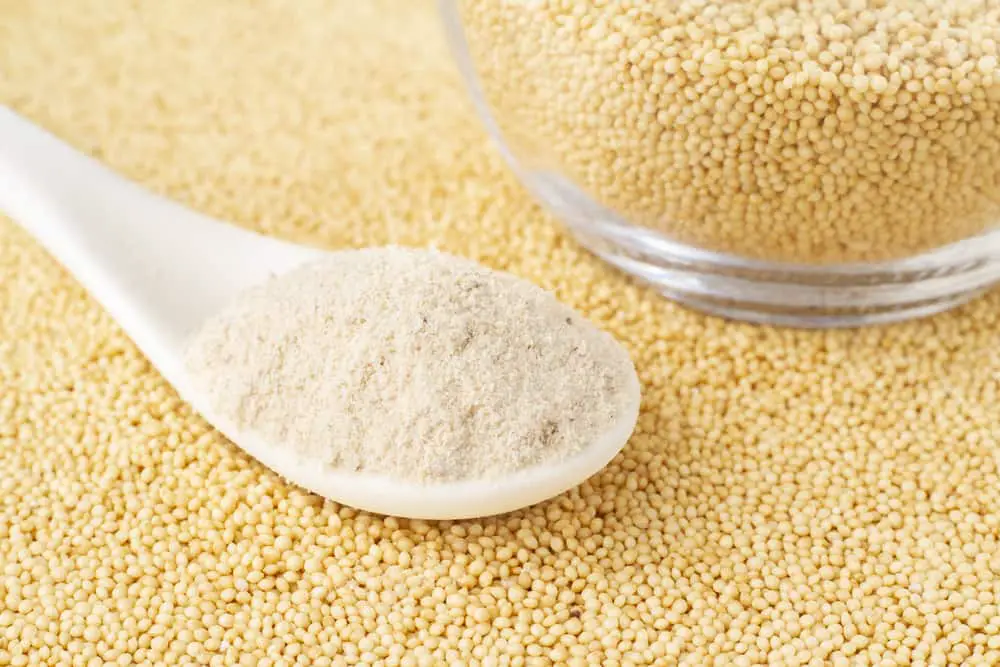Amaranth flour is a gluten-free alternative to wheat, barley, and rye flours. It comes from the plant Amaranthus tricolor, which is believed to have originated in central Mexico or South America. The seeds are ground into a fine powder before being used as an ingredient in cooking recipes. The plant’s seed originates from Mesoamerica, is cultivated throughout North and South America, and is recognized for its high nutritional value.
Amaranth may be eaten as a dessert or a side dish, and it’s prepared in the same way as grain seeds like rice and oats: by simmering. This seed is smaller than other grains and is close in size to a poppy seed.
Is Amaranth Flour Safe to Eat?
The seeds (grains) of the amaranth plant have been eaten for thousands of years, particularly in Mexico and Central America. It is now cultivated and consumed in many locations throughout the world.
Amaranth flour is safe for human consumption and is gluten-free. It is high in protein, fiber, and minerals like magnesium, potassium, and zinc. It has a nutty and slightly sweet taste. This flour is also high in lysine, an amino acid that the body cannot produce and must come from food sources. The flour’s protein can help strengthen hair and nails and promote weight loss when included as part of a low-calorie diet.
Health Benefits of Amaranth
Highly Nutritional
Amaranth is packed with calcium, magnesium, fiber, and proteins. It contains all nine essential amino acids (the building blocks of protein), making it a complete source of plant-based protein in one food.
Promotes Weight Loss
Amaranth is low in carbohydrates and high fiber, making it the perfect food for weight loss.
Aids in Digestion
Amaranth is a high-fiber food that helps regulate digestion and prevent constipation.
Good for the Heart
Amaranth is a good source of magnesium and fiber, which can help reduce blood pressure.
Lowers Cholesterol
Amaranth is a high-fiber food that can help reduce bad cholesterol levels in the body.

Historical Background of Amaranth Flour
The name “amaranth” has its roots in ancient Greece, where it was used as a symbol for immortality because of the long-lasting nature of amaranth crops. Many civilizations have eaten amaranths through time, including many indigenous peoples throughout North and South America, who ate them as staple foods. The use of amaranth can be traced back to the Aztecs, who considered it a sacred plant. They believed that the flour gave strength and vitality and could cure many illnesses. The Incas also cultivated and ate amaranth grains, using them in their bread and porridges.
Amaranth was introduced to Europe in the 16th century, but it did not become popular until the 20th century when gluten-free diets became more widely used. Today, amaranth is cultivated worldwide but remains primarily popular in Central American countries like Guatemala and Nicaragua. In recent years, awareness about gluten intolerance led to increased interest in this versatile flour.
Where Does Amaranth Flour Come From?
This flour comes from the plant Amaranthus tricolor, which is believed to have originated in central Mexico or South America. The seeds are ground into a fine powder before being used as an ingredient in cooking recipes.
Fun Facts
In ancient Greece, the amaranth was used as a symbol of immortality because of the long-lasting nature of its crops. In the Aztec culture, people believed that amaranth grains had mystical powers, giving them strength and vitality. An interesting belief about Amaranth in the Inca culture is that its flower was believed to have been created when lightning struck a grain of amaranth.
Are Amaranth Flour and Quinoa the Same Thing?
No, amaranth flour and quinoa are not the same thing. The protein content in amaranth is higher than in quinoa, particularly healthy proteins like lysine is higher in amaranth. Quinoa is a pseudocereal, while amaranth is an herb. Quinoa has a more earthy flavor profile and contains saponins, which can act as anti-nutrients in the body. Amaranth does not contain saponins.

How Is Amaranth Flour Made?
This flour is made by grinding the seeds of the amaranth plant into a fine powder. The process of milling the seeds into flour can be done at home with a high-quality grain mill or at a commercial facility.
What Is Amaranth Flour Best Used For?
The high protein and fiber content in amaranth make it an ideal flour for baking healthy bread, cakes, and muffins. It can also be used to thicken sauces or to make porridges. This flour has a nutty flavor. You can also use it to make gluten-free pasta. However, the most common use for amaranth flour is in gluten-free baking.
What Does Amaranth Flour Taste Like?
Amaranth flour has a nutty, earthy flavor that goes well with sweet or savory dishes. The taste comes from the high levels of essential amino acids and minerals present in the flour.
What does Amaranth Flour Smell Like?
The smell of amaranth flour is similar to that of other nut flours. It has a slightly sweet and nutty aroma that is pleasant and not overpowering. It does not have a strong smell, and the smell is similar to that of quinoa.
Substitutes for Amaranth Flour
You can use a few substitutes if you don’t have amaranth flour on hand. One option is to use quinoa flour in a one-to-one ratio in recipes that call for amaranth. One cup of quinoa flour equals about one and a half cups of amaranth. If you do not have quinoa, buckwheat or brown rice flours are suitable substitutes. Generally, you should use half as much buckwheat or brown rice flour as amaranth.
In conclusion, this flour is a nutritious and flavor-packed ingredient that can be used in many gluten-free baking recipes. It has a high protein content and essential amino acids, minerals, and vitamins. Amaranth flour is safe for people with gluten intolerance or celiac disease. Try using it for a delicious and healthy treat in your next baking project!
